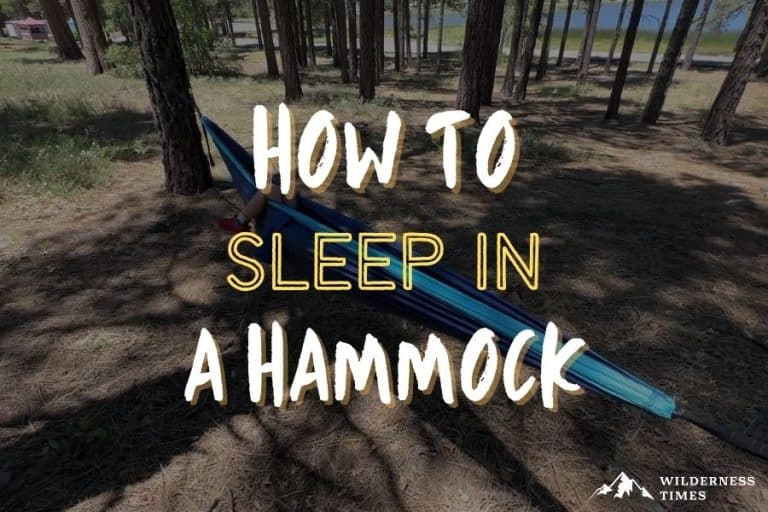Sleeping in a hammock might not seem like the most comfortable way to get a good night’s rest.
You’d be surprised though.
From health benefits to longer and deeper sleep, hammocks have a whole list of advantages over sleeping on the ground.
In this article, I’ll tell you everything you need to know about how to sleep in a hammock and I’ll share with you some valuable tips for extra comfiness.
Ready? Let’s jump straight in.
Table of Contents
TogglePicking The Right Hammock
First things first: you need to pick the right hammock.
When picking a hammock, consider the following:
- Material
- Size
- Accessories
Material
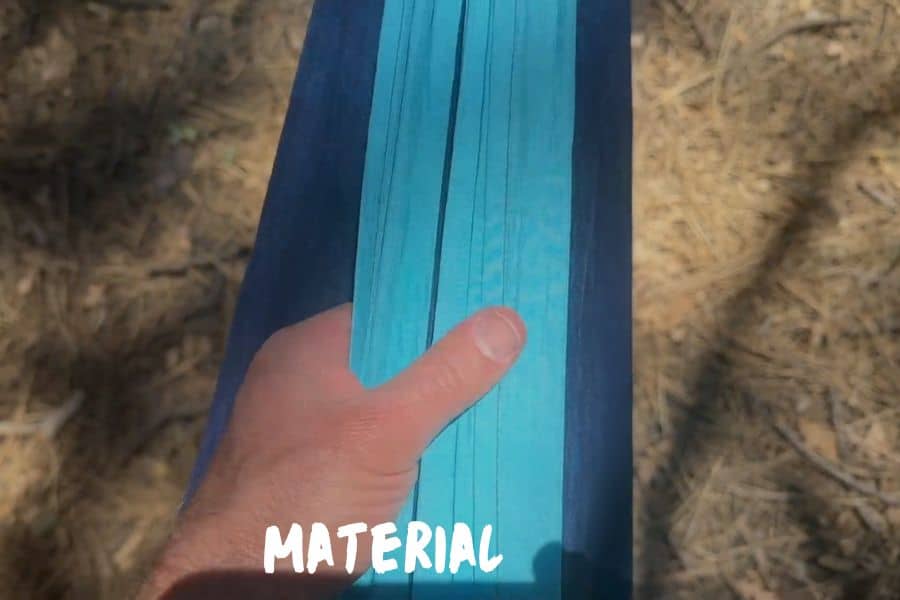
When it comes to the type of material of a camping hammock, you should choose a parachute nylon hammock.
Additional reading: Eno Hammock Review
They may be a bit more expensive compared to rope or cotton hammocks. But, when sleeping for a longer period they are definitely the most comfortable.
A parachute nylon hammock is both breathable and durable. This fabric also has anti-rot/mildew properties, is quick drying, ultralight and can hold a lot of weight, with some hammocks being able to hold up to 400 lbs.
You’ll be delighted at how silky smooth the material feels on your skin, too.
Size
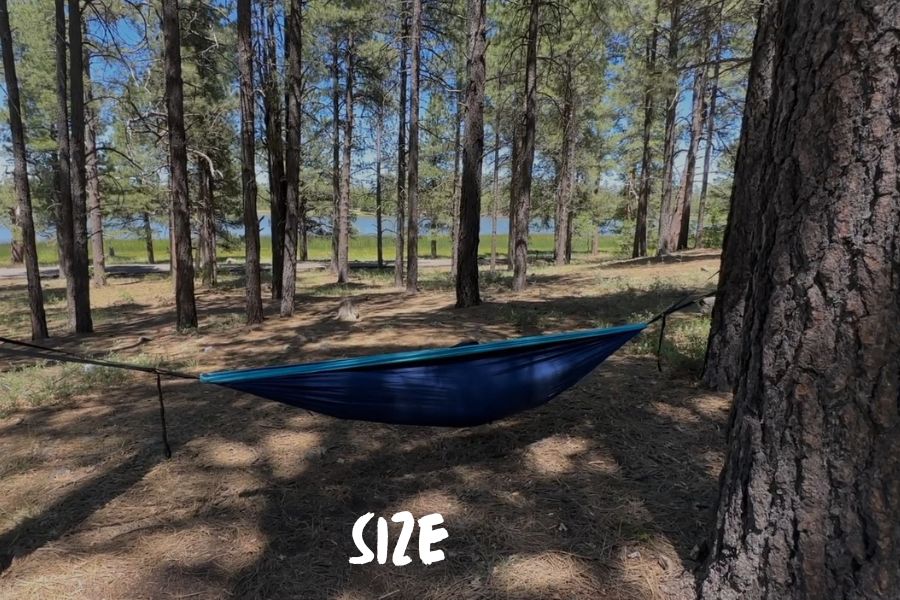
Hammocks come in small, medium, and large sizes. And, also single or double sized.
If you get a bigger hammock, you won’t have to worry about ripping it or overloading it if you want to put in extra pillows or your camping bag.
Most manufacturers display the length of their hammocks and the weight they can withstand. So, be sure to check that info and go for one that is at least two feet longer than your height.
Single or double sized?
Well, if you plan to sleep with someone, definitely get a double hammock. If you sleep alone, you can get a single, but you should go for the double if you want to be extra comfortable.
Sure, a double hammock will be comfier, but if you are backpacking, you might want to keep your load light, so you should make take a single sized hammock.
Accessories
Want to make your sleeping experience even more comfortable? Then you definitely need to invest in some additional accessories.
I’m talking about things like:
- A suspension system for hanging the hammock
- An underquilt or a sleeping bag
- A rain tarp
- A net for bugs
Suspension System
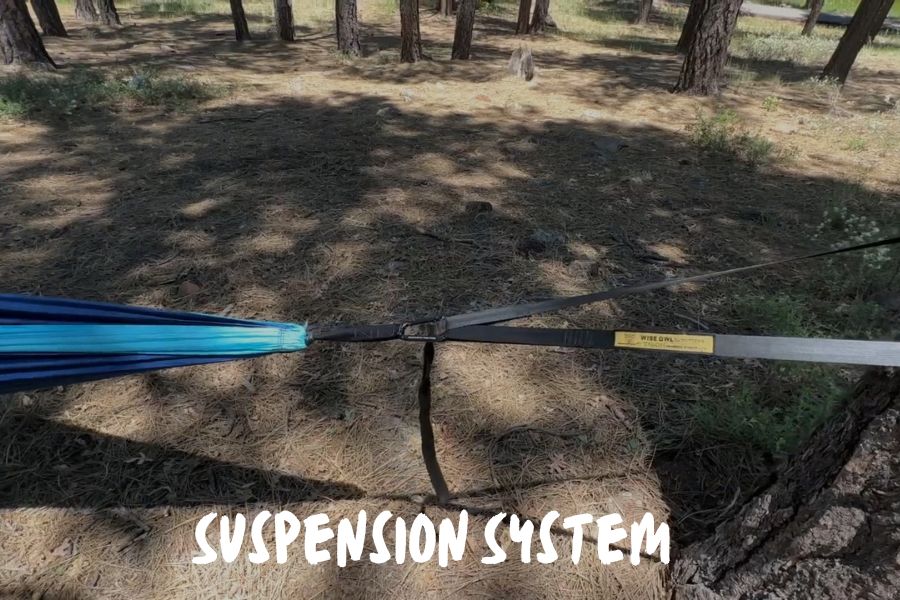
Most hammocks include carabiners that have enough strength to carry the weight. But the webbing, or suspension system, you often need to buy separately.
Be sure that the straps you buy are at least 1 inch wide. Thinner straps may dig into bark and damage trees.
You can also use rope, but this can severely damage the trees, so webbing is a much better option. If you do use rope, be sure to follow Leave No Trace principles by placing sticks in between the rope and the tree trunk.
Underquilts & Sleeping Bags
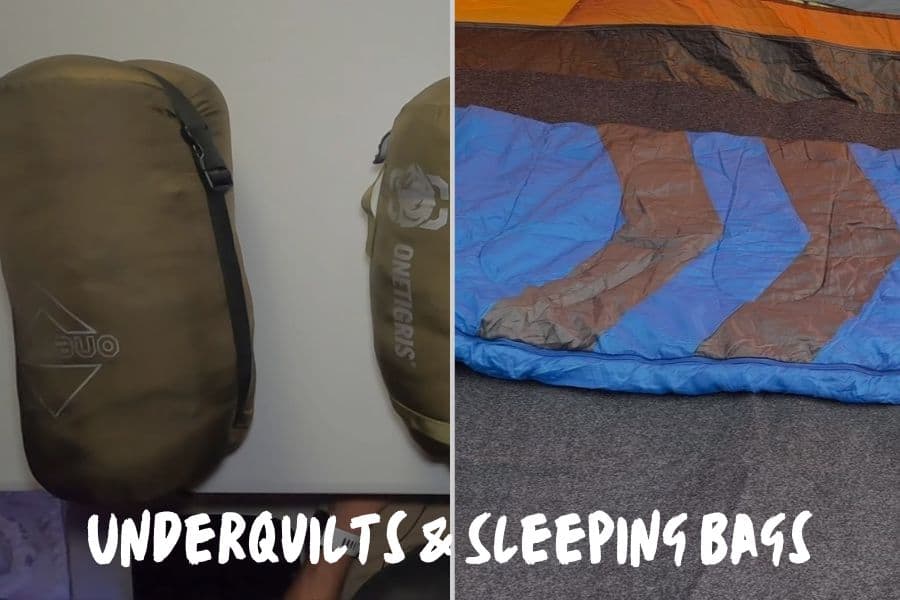
Sleeping outside can be chilly. To make sure you stay comfortable and warm, you have several options – underquilts, sleeping bags, and blankets.
You don’t need to zip your sleeping bag up like you would regularly. It’s actually a better idea to unzip it and use it as a quilt. That way, you’ve got the underquilt heating you from below and the sleeping bag heating you from above.
If you don’t have a sleeping bag, don’t worry. Plenty of blankets will also do the trick.
Just remember to take something with you to keep you warm and comfy throughout the night.
Sleeping Pad
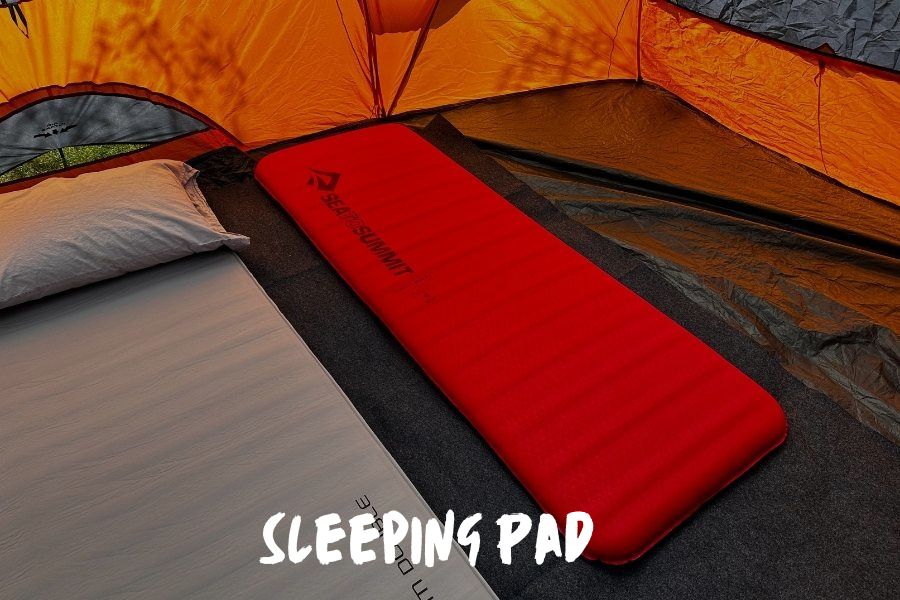
Placing a sleeping pad inside your hammock will surely make your sleeping experience comfier. It will also help you to stay in place and stay warm.
While both foam pads and air pads will work in a hammock, foam sleeping pads are cheaper and more durable than their inflatable counterparts.
If you’re a backpacker, your pad should weigh around 1 lb. (or less). Every ounce counts when you’re carrying all of your gear on your back, so the lighter, the better.
Rain Tarp
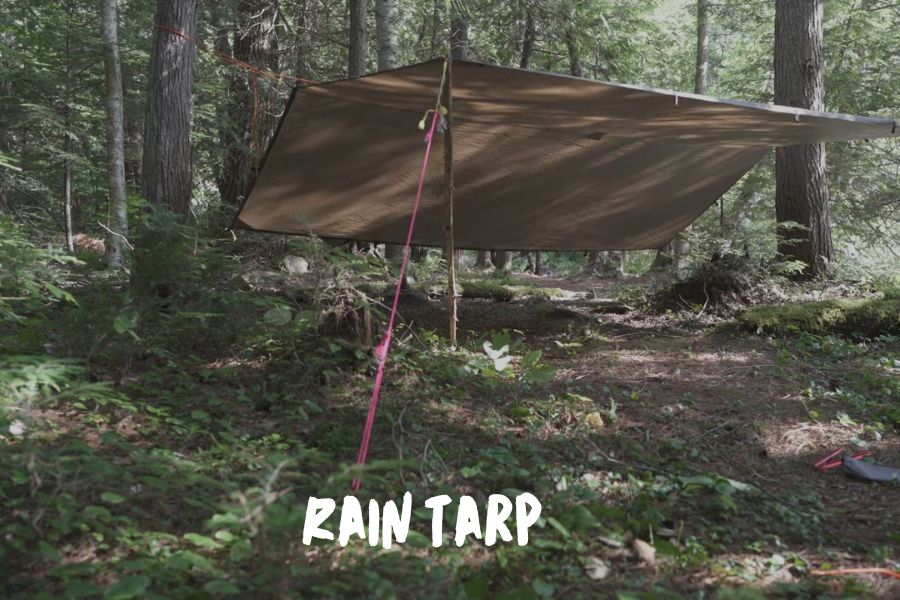
A rain tarp is a piece of fabric that hangs above the hammock in the shape of a pyramid to keep the rain from falling on you.
Bigger rain tarps will protect you more from the rain.
If you are sure the weather will be dry, you don’t need a rain tarp. But if there is a possibility of rain, it will definitely come in handy.
And, let’s face it.
How sure can you ever really be?
Bug Net
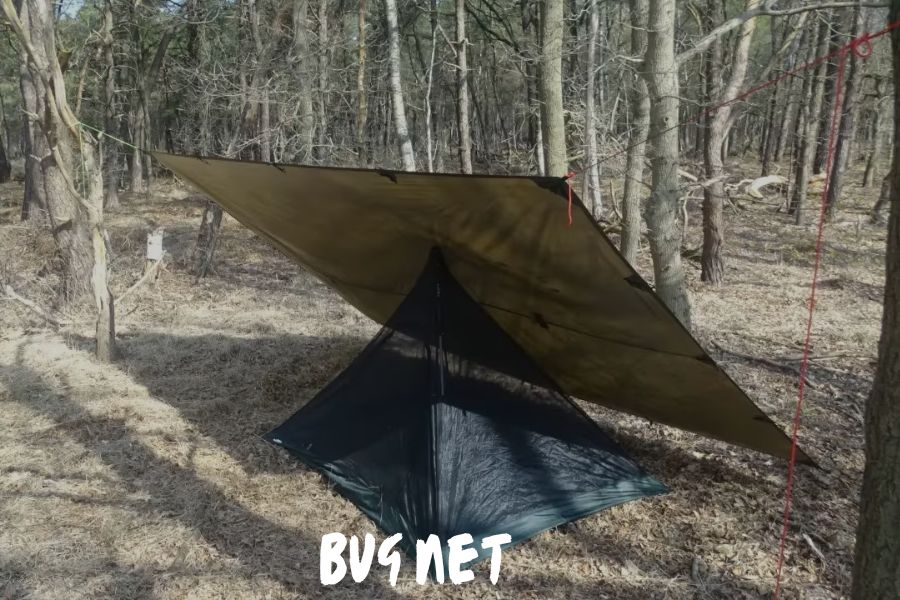
When it comes to bug nets, the best are the models with 360-degree protection.
It might seem crazy, but hammocks are thin, so it’s better to have your back protected from the bugs as well.
You don’t want to wake up in the middle of the night with mosquitos buzzing underneath you or biting your back.
Hanging The Hammock
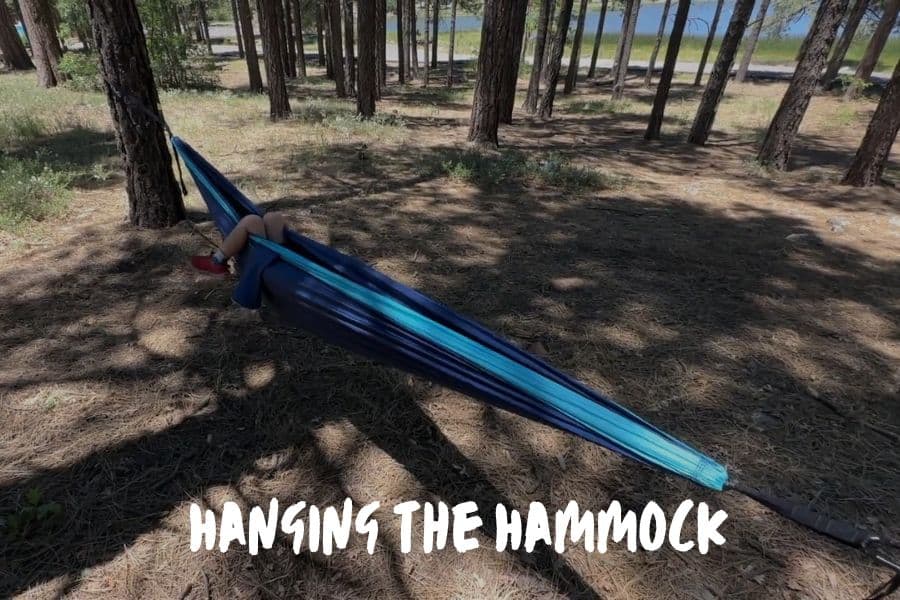
Here’s what you need to do:
First, find two trees that are at least 12 to 15 feet apart.
Make sure that the trees you choose are healthy and firm and will not move or sway in the wind. Also, check they don’t have any signs of nests or other creatures making their homes there.
Between the hammock line and the tree you should have a 30-45 degree hang angle.
Don’t string up the hammock as tight as possible.
Instead, hang it with a good sag. Imagine it like a smiley face.
This is the most important thing to remember when hanging your hammock. It will make sleeping in a hammock much comfier.
A deep curve also has a lower center of gravitation, making the hammock much more stable and harder to fall out of.
6 Tips For Sleeping In A Hammock Comfortably
Let’s go through some tips you should keep in mind to make your experience of sleeping in a hammock from bearable to amazing.
Use Pillows To Support Your Neck & Back
Treat your hammock like a bed and include comforting details.
Like lots of pillows and blankets.
For lower back support, put an extra pillow under your knees. If you don’t have an extra pillow you can roll a blanket up and use that instead.
You can experiment by putting pieces of clothing underneath parts of your body, to figure out what’s the most comfy for you.
Also, remember to place your underquilt or sleeping bag in your hammock, this will keep you comfy and warm.
Sleep In The Right Position
Position yourself at an angle while lying on your back so your body makes a diagonal line in the hammock.
This sleeping position will ensure your weight is well supported in the hammock and prevent you from sinking too deeply into the material.
You’ll be amazed at how comfortable this feels. Your head and feet will be on the same level so that your body reclines ergonomically flat across the fabric.
Your body may naturally slide to the middle of your hammock, which can be uncomfortable. To prevent any sliding, try hanging the foot side of the hammock about 8 to 10 inches higher. This helps keep your torso from sliding into the middle.
Make Sure You Have Everything You Need To Stay Warm
Wrap yourself up in the hammock fabric or a blanket to stay warm.
If the hammock has extra fabric on either side, wrap it around you so you are cocooned in the hammock.
You can also wrap yourself in a sleeping bag or blanket to stay warm throughout the night. However warm the weather might seem, nature is always chilly at night.
I suggest you sleep in warm sleeping clothes like long underwear, socks, and long sleeves. It’s also good to have a warm beanie in case it gets icy cold during the night.
With warm clothes, an underquilt and a sleeping bag, you’ll be ready to sleep beautifully even if it gets very cold throughout the night.
Protect Yourself From The Rain
If it is raining, along with a rain tarp, you should make a drip line on your suspension.
A drip line is just a piece of knotted rope that’s positioned about six or eight inches away from the tree or other tarp-anchoring source.
This will prevent rainwater from seeping down your suspension straps and getting your hammock wet.
Protect Yourself From Bugs
Use a 360-degree bug net like the one pictured above to protect yourself from bugs.
You can also use apple cider vinegar for bug protection.
Pour it in a glass and place it next to the trees that your hammock is hanging from. You can also put a bit on your wrists, ankles, and neck.
The smell of the vinegar will keep you safe from mosquitos.
The vinegar in the glasses next to the trees will attract the bugs and will keep them away from you. It might sound contradictory, but trust me it works.
Keep Safety In Mind
Just like when you’re sleeping in a tent, do not keep food in your hammock.
Food can attract animals during the night and you don’t want to be woken up by a bear sniffing you.
Even if there aren’t bears in the area, it’s still not a good idea to keep food in your hammock. Nature is filled with all kinds of critters and all of them get hungry at some point.
To prevent dangerous falls, hang your hammock no more than 3 feet off the ground.
Do not hang your hammock over water features, chasms in the ground, or above tables or sharp objects.
Do not hang more than one hammock on one tree. If you are going with friends, find a place where everyone can hang their hammock on separate trees.
Let’s Wrap It Up
OK, so what have we learned?
- Choose a hammock made out of parachute nylon material. Make sure the size of the hammock is big enough to keep you comfy while sleeping.
- Hang your hammock safely between trees that are 12 to 15 feet apart and not higher than 3 feet off the ground. Hang it with a curve like the mouth on a smiley face.
- Have pillows and blankets to ensure your comfiness. And, throw in an underquilt and a sleeping bag to make sure you stay warm in your hammock.
- Lay diagonally in your hammock. This will feel much comfier than laying in the center and looking like a banana.
- Protect yourself from rain and bugs with your prepared accessories.
- Don’t keep food in your hammock.
Voila, enjoy your sleeping in a hammock. Once you try it you’ll never want to go back to sleeping in a tent again.


